Marketing Strategies of Aldi Australia: A Comprehensive Report
VerifiedAdded on 2022/11/01
|12
|2924
|327
Report
AI Summary
This report provides a comprehensive analysis of Aldi Australia's marketing strategies since its launch in 2001. It examines Aldi's current marketing approach, focusing on low pricing, private labeling, and a focus on fresh food products. The report delves into Aldi's competitive position within t...
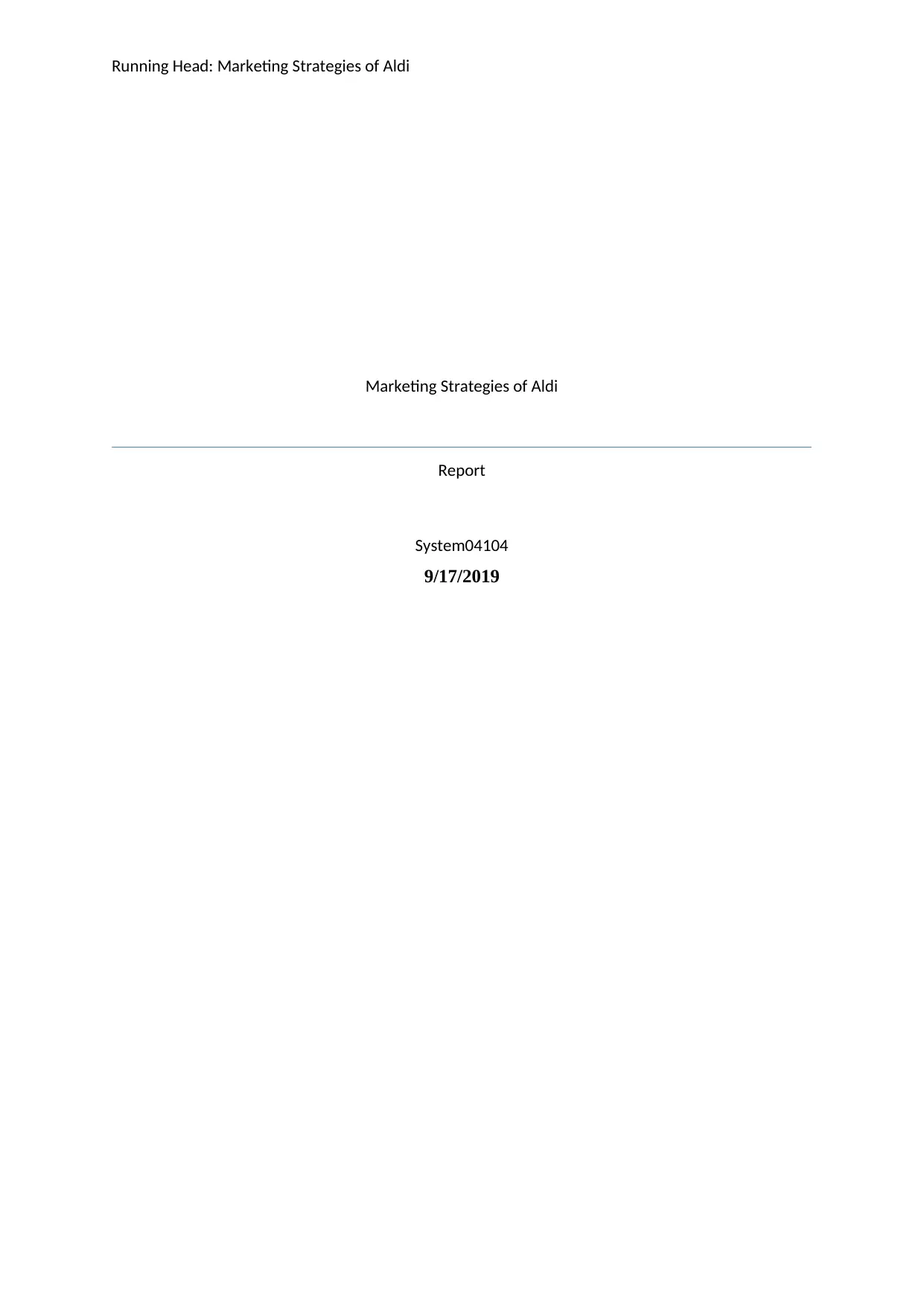
Running Head: Marketing Strategies of Aldi
Marketing Strategies of Aldi
Report
System04104
9/17/2019
Marketing Strategies of Aldi
Report
System04104
9/17/2019
Paraphrase This Document
Need a fresh take? Get an instant paraphrase of this document with our AI Paraphraser
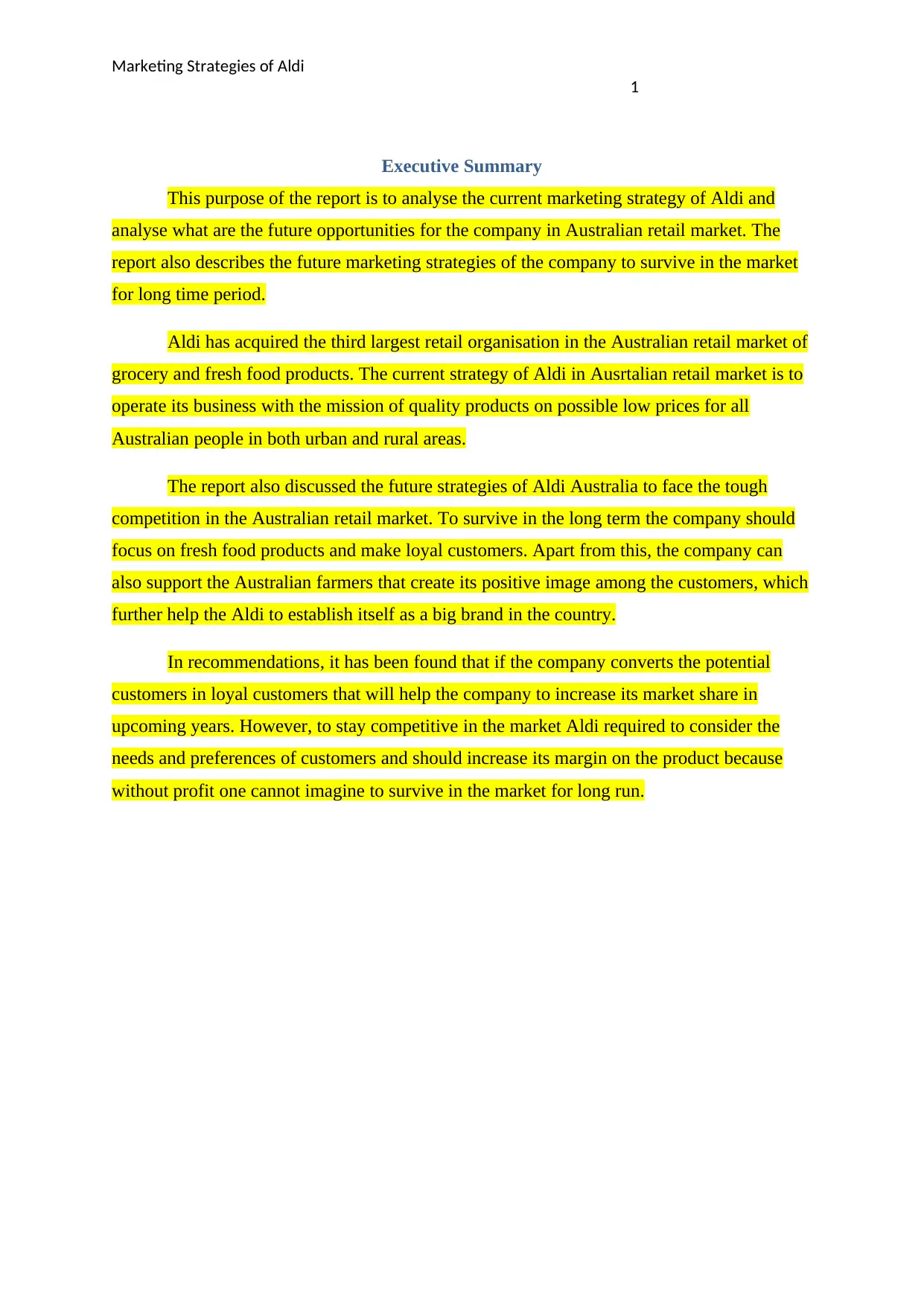
Marketing Strategies of Aldi
1
Executive Summary
This purpose of the report is to analyse the current marketing strategy of Aldi and
analyse what are the future opportunities for the company in Australian retail market. The
report also describes the future marketing strategies of the company to survive in the market
for long time period.
Aldi has acquired the third largest retail organisation in the Australian retail market of
grocery and fresh food products. The current strategy of Aldi in Ausrtalian retail market is to
operate its business with the mission of quality products on possible low prices for all
Australian people in both urban and rural areas.
The report also discussed the future strategies of Aldi Australia to face the tough
competition in the Australian retail market. To survive in the long term the company should
focus on fresh food products and make loyal customers. Apart from this, the company can
also support the Australian farmers that create its positive image among the customers, which
further help the Aldi to establish itself as a big brand in the country.
In recommendations, it has been found that if the company converts the potential
customers in loyal customers that will help the company to increase its market share in
upcoming years. However, to stay competitive in the market Aldi required to consider the
needs and preferences of customers and should increase its margin on the product because
without profit one cannot imagine to survive in the market for long run.
1
Executive Summary
This purpose of the report is to analyse the current marketing strategy of Aldi and
analyse what are the future opportunities for the company in Australian retail market. The
report also describes the future marketing strategies of the company to survive in the market
for long time period.
Aldi has acquired the third largest retail organisation in the Australian retail market of
grocery and fresh food products. The current strategy of Aldi in Ausrtalian retail market is to
operate its business with the mission of quality products on possible low prices for all
Australian people in both urban and rural areas.
The report also discussed the future strategies of Aldi Australia to face the tough
competition in the Australian retail market. To survive in the long term the company should
focus on fresh food products and make loyal customers. Apart from this, the company can
also support the Australian farmers that create its positive image among the customers, which
further help the Aldi to establish itself as a big brand in the country.
In recommendations, it has been found that if the company converts the potential
customers in loyal customers that will help the company to increase its market share in
upcoming years. However, to stay competitive in the market Aldi required to consider the
needs and preferences of customers and should increase its margin on the product because
without profit one cannot imagine to survive in the market for long run.
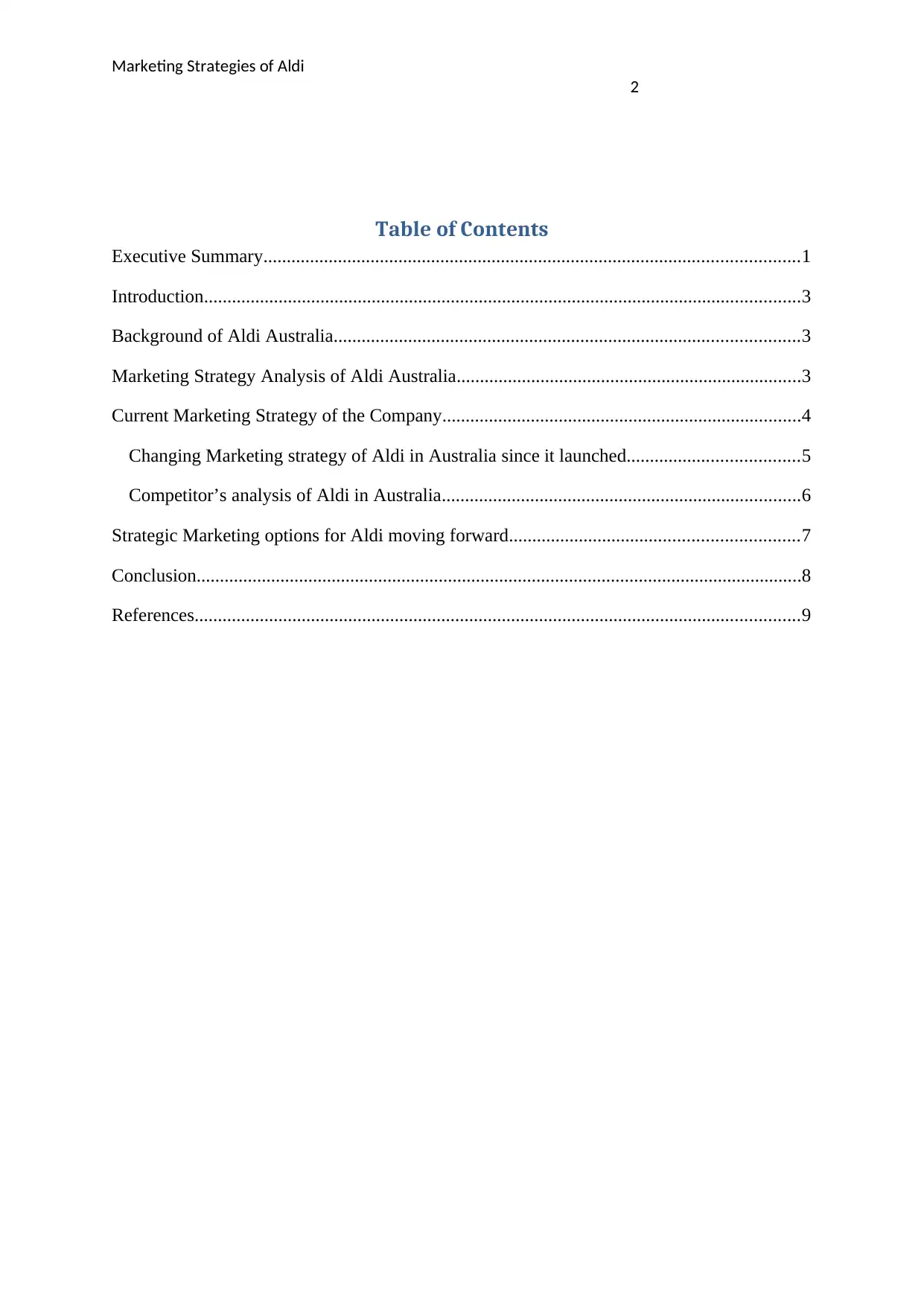
Marketing Strategies of Aldi
2
Table of Contents
Executive Summary...................................................................................................................1
Introduction................................................................................................................................3
Background of Aldi Australia....................................................................................................3
Marketing Strategy Analysis of Aldi Australia..........................................................................3
Current Marketing Strategy of the Company.............................................................................4
Changing Marketing strategy of Aldi in Australia since it launched.....................................5
Competitor’s analysis of Aldi in Australia.............................................................................6
Strategic Marketing options for Aldi moving forward..............................................................7
Conclusion..................................................................................................................................8
References..................................................................................................................................9
2
Table of Contents
Executive Summary...................................................................................................................1
Introduction................................................................................................................................3
Background of Aldi Australia....................................................................................................3
Marketing Strategy Analysis of Aldi Australia..........................................................................3
Current Marketing Strategy of the Company.............................................................................4
Changing Marketing strategy of Aldi in Australia since it launched.....................................5
Competitor’s analysis of Aldi in Australia.............................................................................6
Strategic Marketing options for Aldi moving forward..............................................................7
Conclusion..................................................................................................................................8
References..................................................................................................................................9
⊘ This is a preview!⊘
Do you want full access?
Subscribe today to unlock all pages.

Trusted by 1+ million students worldwide
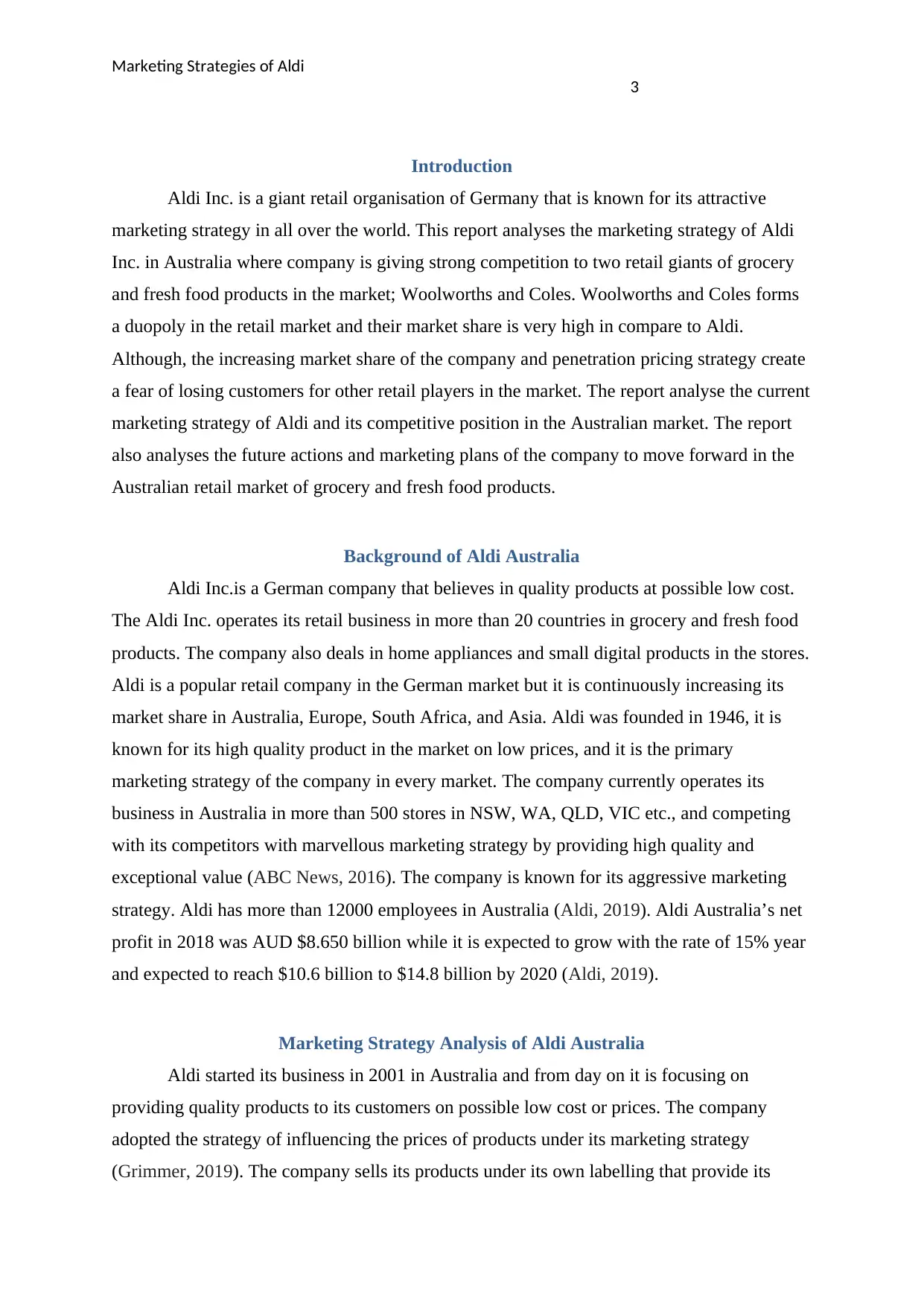
Marketing Strategies of Aldi
3
Introduction
Aldi Inc. is a giant retail organisation of Germany that is known for its attractive
marketing strategy in all over the world. This report analyses the marketing strategy of Aldi
Inc. in Australia where company is giving strong competition to two retail giants of grocery
and fresh food products in the market; Woolworths and Coles. Woolworths and Coles forms
a duopoly in the retail market and their market share is very high in compare to Aldi.
Although, the increasing market share of the company and penetration pricing strategy create
a fear of losing customers for other retail players in the market. The report analyse the current
marketing strategy of Aldi and its competitive position in the Australian market. The report
also analyses the future actions and marketing plans of the company to move forward in the
Australian retail market of grocery and fresh food products.
Background of Aldi Australia
Aldi Inc.is a German company that believes in quality products at possible low cost.
The Aldi Inc. operates its retail business in more than 20 countries in grocery and fresh food
products. The company also deals in home appliances and small digital products in the stores.
Aldi is a popular retail company in the German market but it is continuously increasing its
market share in Australia, Europe, South Africa, and Asia. Aldi was founded in 1946, it is
known for its high quality product in the market on low prices, and it is the primary
marketing strategy of the company in every market. The company currently operates its
business in Australia in more than 500 stores in NSW, WA, QLD, VIC etc., and competing
with its competitors with marvellous marketing strategy by providing high quality and
exceptional value (ABC News, 2016). The company is known for its aggressive marketing
strategy. Aldi has more than 12000 employees in Australia (Aldi, 2019). Aldi Australia’s net
profit in 2018 was AUD $8.650 billion while it is expected to grow with the rate of 15% year
and expected to reach $10.6 billion to $14.8 billion by 2020 (Aldi, 2019).
Marketing Strategy Analysis of Aldi Australia
Aldi started its business in 2001 in Australia and from day on it is focusing on
providing quality products to its customers on possible low cost or prices. The company
adopted the strategy of influencing the prices of products under its marketing strategy
(Grimmer, 2019). The company sells its products under its own labelling that provide its
3
Introduction
Aldi Inc. is a giant retail organisation of Germany that is known for its attractive
marketing strategy in all over the world. This report analyses the marketing strategy of Aldi
Inc. in Australia where company is giving strong competition to two retail giants of grocery
and fresh food products in the market; Woolworths and Coles. Woolworths and Coles forms
a duopoly in the retail market and their market share is very high in compare to Aldi.
Although, the increasing market share of the company and penetration pricing strategy create
a fear of losing customers for other retail players in the market. The report analyse the current
marketing strategy of Aldi and its competitive position in the Australian market. The report
also analyses the future actions and marketing plans of the company to move forward in the
Australian retail market of grocery and fresh food products.
Background of Aldi Australia
Aldi Inc.is a German company that believes in quality products at possible low cost.
The Aldi Inc. operates its retail business in more than 20 countries in grocery and fresh food
products. The company also deals in home appliances and small digital products in the stores.
Aldi is a popular retail company in the German market but it is continuously increasing its
market share in Australia, Europe, South Africa, and Asia. Aldi was founded in 1946, it is
known for its high quality product in the market on low prices, and it is the primary
marketing strategy of the company in every market. The company currently operates its
business in Australia in more than 500 stores in NSW, WA, QLD, VIC etc., and competing
with its competitors with marvellous marketing strategy by providing high quality and
exceptional value (ABC News, 2016). The company is known for its aggressive marketing
strategy. Aldi has more than 12000 employees in Australia (Aldi, 2019). Aldi Australia’s net
profit in 2018 was AUD $8.650 billion while it is expected to grow with the rate of 15% year
and expected to reach $10.6 billion to $14.8 billion by 2020 (Aldi, 2019).
Marketing Strategy Analysis of Aldi Australia
Aldi started its business in 2001 in Australia and from day on it is focusing on
providing quality products to its customers on possible low cost or prices. The company
adopted the strategy of influencing the prices of products under its marketing strategy
(Grimmer, 2019). The company sells its products under its own labelling that provide its
Paraphrase This Document
Need a fresh take? Get an instant paraphrase of this document with our AI Paraphraser
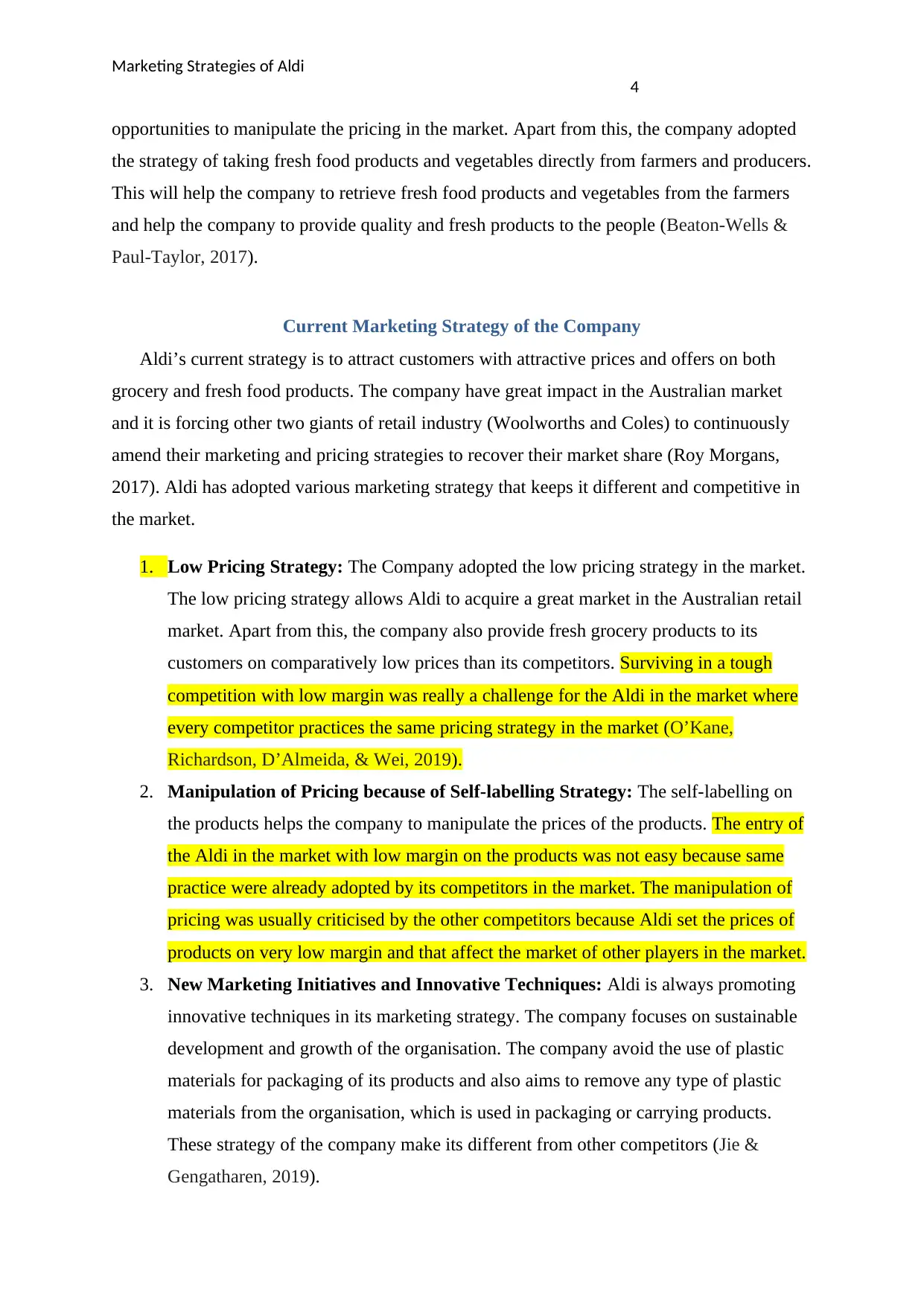
Marketing Strategies of Aldi
4
opportunities to manipulate the pricing in the market. Apart from this, the company adopted
the strategy of taking fresh food products and vegetables directly from farmers and producers.
This will help the company to retrieve fresh food products and vegetables from the farmers
and help the company to provide quality and fresh products to the people (Beaton-Wells &
Paul-Taylor, 2017).
Current Marketing Strategy of the Company
Aldi’s current strategy is to attract customers with attractive prices and offers on both
grocery and fresh food products. The company have great impact in the Australian market
and it is forcing other two giants of retail industry (Woolworths and Coles) to continuously
amend their marketing and pricing strategies to recover their market share (Roy Morgans,
2017). Aldi has adopted various marketing strategy that keeps it different and competitive in
the market.
1. Low Pricing Strategy: The Company adopted the low pricing strategy in the market.
The low pricing strategy allows Aldi to acquire a great market in the Australian retail
market. Apart from this, the company also provide fresh grocery products to its
customers on comparatively low prices than its competitors. Surviving in a tough
competition with low margin was really a challenge for the Aldi in the market where
every competitor practices the same pricing strategy in the market (O’Kane,
Richardson, D’Almeida, & Wei, 2019).
2. Manipulation of Pricing because of Self-labelling Strategy: The self-labelling on
the products helps the company to manipulate the prices of the products. The entry of
the Aldi in the market with low margin on the products was not easy because same
practice were already adopted by its competitors in the market. The manipulation of
pricing was usually criticised by the other competitors because Aldi set the prices of
products on very low margin and that affect the market of other players in the market.
3. New Marketing Initiatives and Innovative Techniques: Aldi is always promoting
innovative techniques in its marketing strategy. The company focuses on sustainable
development and growth of the organisation. The company avoid the use of plastic
materials for packaging of its products and also aims to remove any type of plastic
materials from the organisation, which is used in packaging or carrying products.
These strategy of the company make its different from other competitors (Jie &
Gengatharen, 2019).
4
opportunities to manipulate the pricing in the market. Apart from this, the company adopted
the strategy of taking fresh food products and vegetables directly from farmers and producers.
This will help the company to retrieve fresh food products and vegetables from the farmers
and help the company to provide quality and fresh products to the people (Beaton-Wells &
Paul-Taylor, 2017).
Current Marketing Strategy of the Company
Aldi’s current strategy is to attract customers with attractive prices and offers on both
grocery and fresh food products. The company have great impact in the Australian market
and it is forcing other two giants of retail industry (Woolworths and Coles) to continuously
amend their marketing and pricing strategies to recover their market share (Roy Morgans,
2017). Aldi has adopted various marketing strategy that keeps it different and competitive in
the market.
1. Low Pricing Strategy: The Company adopted the low pricing strategy in the market.
The low pricing strategy allows Aldi to acquire a great market in the Australian retail
market. Apart from this, the company also provide fresh grocery products to its
customers on comparatively low prices than its competitors. Surviving in a tough
competition with low margin was really a challenge for the Aldi in the market where
every competitor practices the same pricing strategy in the market (O’Kane,
Richardson, D’Almeida, & Wei, 2019).
2. Manipulation of Pricing because of Self-labelling Strategy: The self-labelling on
the products helps the company to manipulate the prices of the products. The entry of
the Aldi in the market with low margin on the products was not easy because same
practice were already adopted by its competitors in the market. The manipulation of
pricing was usually criticised by the other competitors because Aldi set the prices of
products on very low margin and that affect the market of other players in the market.
3. New Marketing Initiatives and Innovative Techniques: Aldi is always promoting
innovative techniques in its marketing strategy. The company focuses on sustainable
development and growth of the organisation. The company avoid the use of plastic
materials for packaging of its products and also aims to remove any type of plastic
materials from the organisation, which is used in packaging or carrying products.
These strategy of the company make its different from other competitors (Jie &
Gengatharen, 2019).
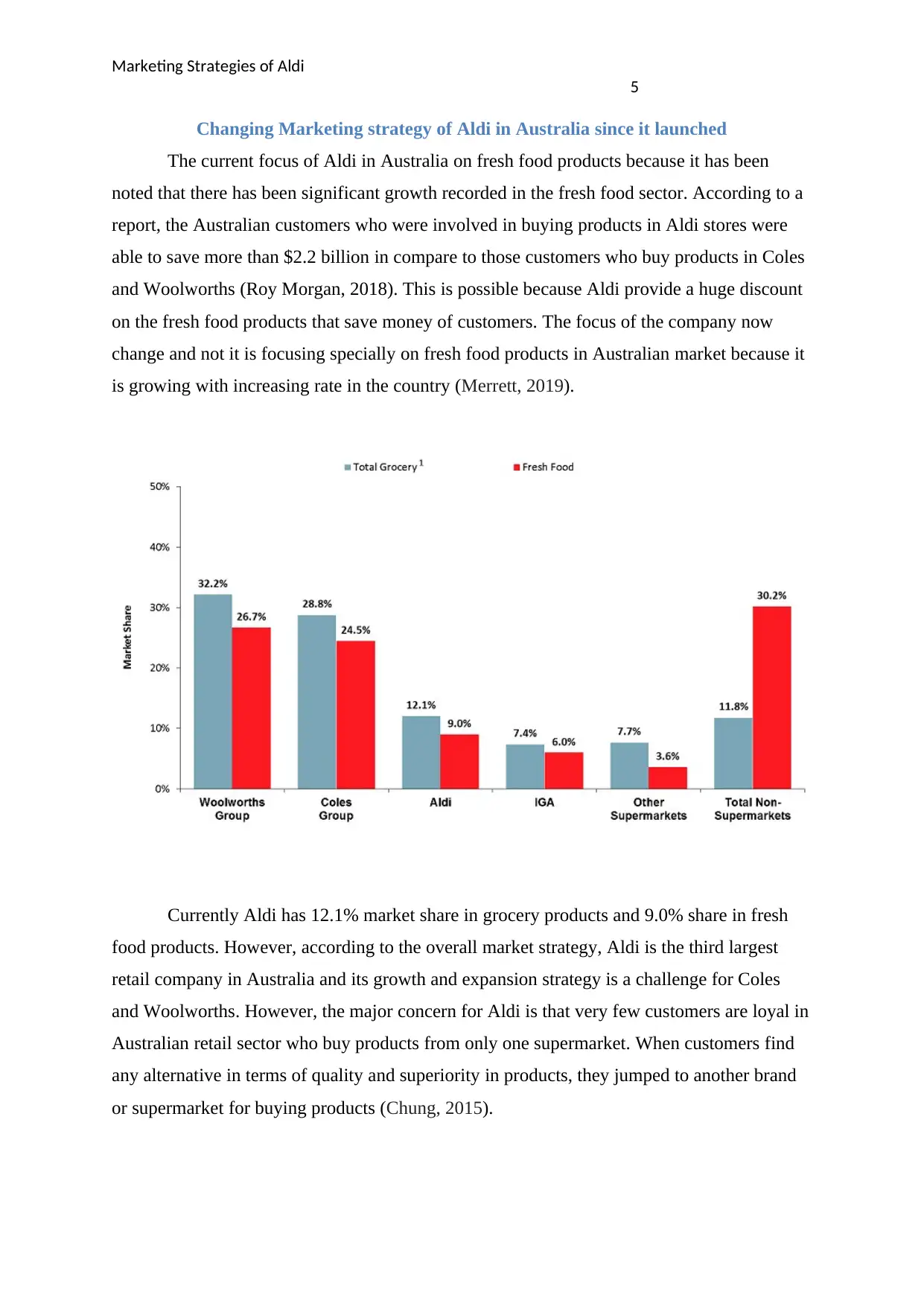
Marketing Strategies of Aldi
5
Changing Marketing strategy of Aldi in Australia since it launched
The current focus of Aldi in Australia on fresh food products because it has been
noted that there has been significant growth recorded in the fresh food sector. According to a
report, the Australian customers who were involved in buying products in Aldi stores were
able to save more than $2.2 billion in compare to those customers who buy products in Coles
and Woolworths (Roy Morgan, 2018). This is possible because Aldi provide a huge discount
on the fresh food products that save money of customers. The focus of the company now
change and not it is focusing specially on fresh food products in Australian market because it
is growing with increasing rate in the country (Merrett, 2019).
Currently Aldi has 12.1% market share in grocery products and 9.0% share in fresh
food products. However, according to the overall market strategy, Aldi is the third largest
retail company in Australia and its growth and expansion strategy is a challenge for Coles
and Woolworths. However, the major concern for Aldi is that very few customers are loyal in
Australian retail sector who buy products from only one supermarket. When customers find
any alternative in terms of quality and superiority in products, they jumped to another brand
or supermarket for buying products (Chung, 2015).
5
Changing Marketing strategy of Aldi in Australia since it launched
The current focus of Aldi in Australia on fresh food products because it has been
noted that there has been significant growth recorded in the fresh food sector. According to a
report, the Australian customers who were involved in buying products in Aldi stores were
able to save more than $2.2 billion in compare to those customers who buy products in Coles
and Woolworths (Roy Morgan, 2018). This is possible because Aldi provide a huge discount
on the fresh food products that save money of customers. The focus of the company now
change and not it is focusing specially on fresh food products in Australian market because it
is growing with increasing rate in the country (Merrett, 2019).
Currently Aldi has 12.1% market share in grocery products and 9.0% share in fresh
food products. However, according to the overall market strategy, Aldi is the third largest
retail company in Australia and its growth and expansion strategy is a challenge for Coles
and Woolworths. However, the major concern for Aldi is that very few customers are loyal in
Australian retail sector who buy products from only one supermarket. When customers find
any alternative in terms of quality and superiority in products, they jumped to another brand
or supermarket for buying products (Chung, 2015).
⊘ This is a preview!⊘
Do you want full access?
Subscribe today to unlock all pages.

Trusted by 1+ million students worldwide

Marketing Strategies of Aldi
6
(Source: Cameron, Sayers, Sacks, & Thornton, 2015)
SWOT Analysis of Aldi
SWOT analysis of the company shows the internal factors (Strength and Weakness) that affect the
performance of the company and external factors (opportunities and threats) that provide threats
and opportunities for the business organisation.
Aldi is currently focuses on enhancing its efficiency to manage its low cost strategy
and low profit margin. Apart from this, the company’s strategy of focusing on single segment
6
(Source: Cameron, Sayers, Sacks, & Thornton, 2015)
SWOT Analysis of Aldi
SWOT analysis of the company shows the internal factors (Strength and Weakness) that affect the
performance of the company and external factors (opportunities and threats) that provide threats
and opportunities for the business organisation.
Aldi is currently focuses on enhancing its efficiency to manage its low cost strategy
and low profit margin. Apart from this, the company’s strategy of focusing on single segment
Paraphrase This Document
Need a fresh take? Get an instant paraphrase of this document with our AI Paraphraser
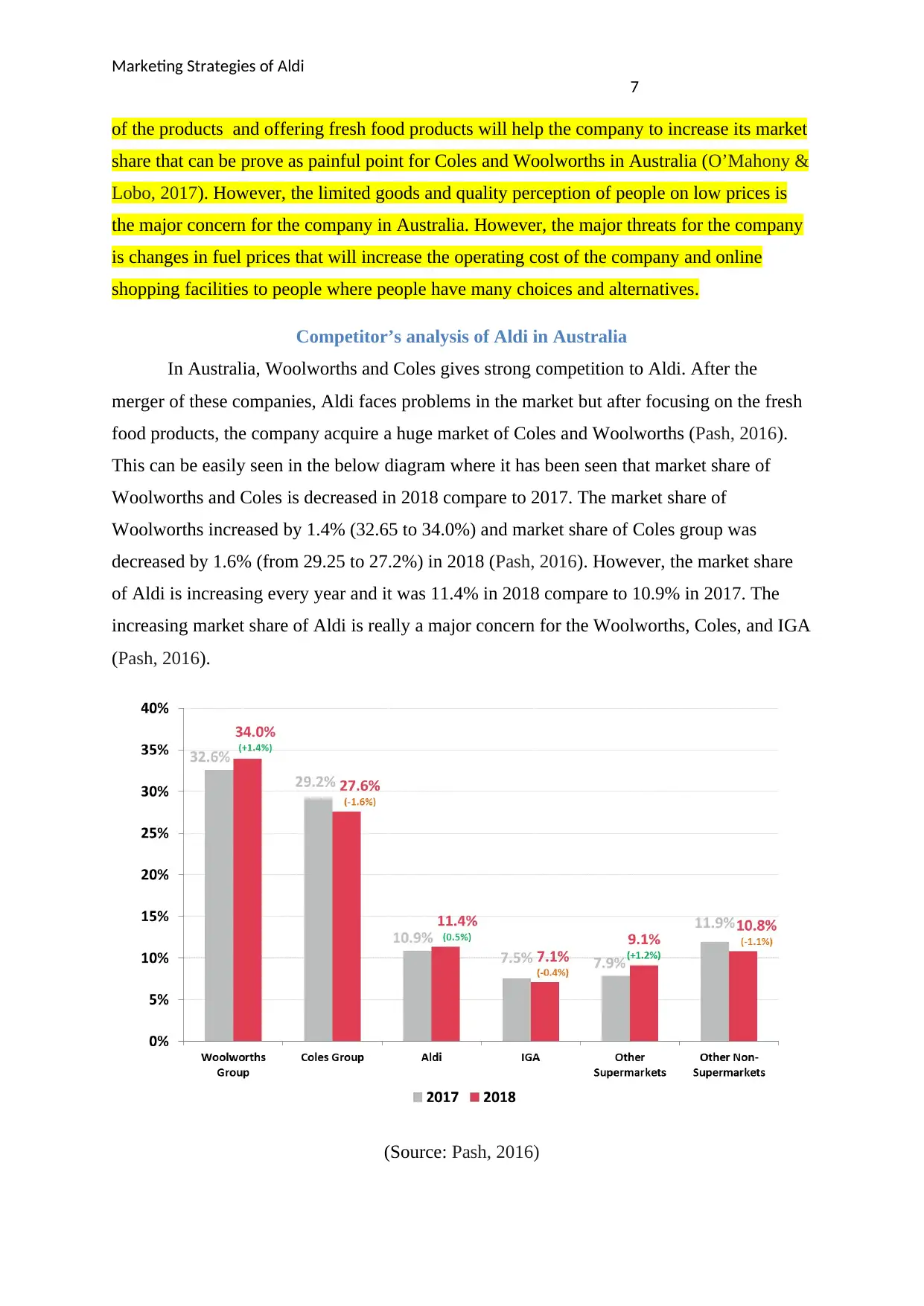
Marketing Strategies of Aldi
7
of the products and offering fresh food products will help the company to increase its market
share that can be prove as painful point for Coles and Woolworths in Australia (O’Mahony &
Lobo, 2017). However, the limited goods and quality perception of people on low prices is
the major concern for the company in Australia. However, the major threats for the company
is changes in fuel prices that will increase the operating cost of the company and online
shopping facilities to people where people have many choices and alternatives.
Competitor’s analysis of Aldi in Australia
In Australia, Woolworths and Coles gives strong competition to Aldi. After the
merger of these companies, Aldi faces problems in the market but after focusing on the fresh
food products, the company acquire a huge market of Coles and Woolworths (Pash, 2016).
This can be easily seen in the below diagram where it has been seen that market share of
Woolworths and Coles is decreased in 2018 compare to 2017. The market share of
Woolworths increased by 1.4% (32.65 to 34.0%) and market share of Coles group was
decreased by 1.6% (from 29.25 to 27.2%) in 2018 (Pash, 2016). However, the market share
of Aldi is increasing every year and it was 11.4% in 2018 compare to 10.9% in 2017. The
increasing market share of Aldi is really a major concern for the Woolworths, Coles, and IGA
(Pash, 2016).
(Source: Pash, 2016)
7
of the products and offering fresh food products will help the company to increase its market
share that can be prove as painful point for Coles and Woolworths in Australia (O’Mahony &
Lobo, 2017). However, the limited goods and quality perception of people on low prices is
the major concern for the company in Australia. However, the major threats for the company
is changes in fuel prices that will increase the operating cost of the company and online
shopping facilities to people where people have many choices and alternatives.
Competitor’s analysis of Aldi in Australia
In Australia, Woolworths and Coles gives strong competition to Aldi. After the
merger of these companies, Aldi faces problems in the market but after focusing on the fresh
food products, the company acquire a huge market of Coles and Woolworths (Pash, 2016).
This can be easily seen in the below diagram where it has been seen that market share of
Woolworths and Coles is decreased in 2018 compare to 2017. The market share of
Woolworths increased by 1.4% (32.65 to 34.0%) and market share of Coles group was
decreased by 1.6% (from 29.25 to 27.2%) in 2018 (Pash, 2016). However, the market share
of Aldi is increasing every year and it was 11.4% in 2018 compare to 10.9% in 2017. The
increasing market share of Aldi is really a major concern for the Woolworths, Coles, and IGA
(Pash, 2016).
(Source: Pash, 2016)
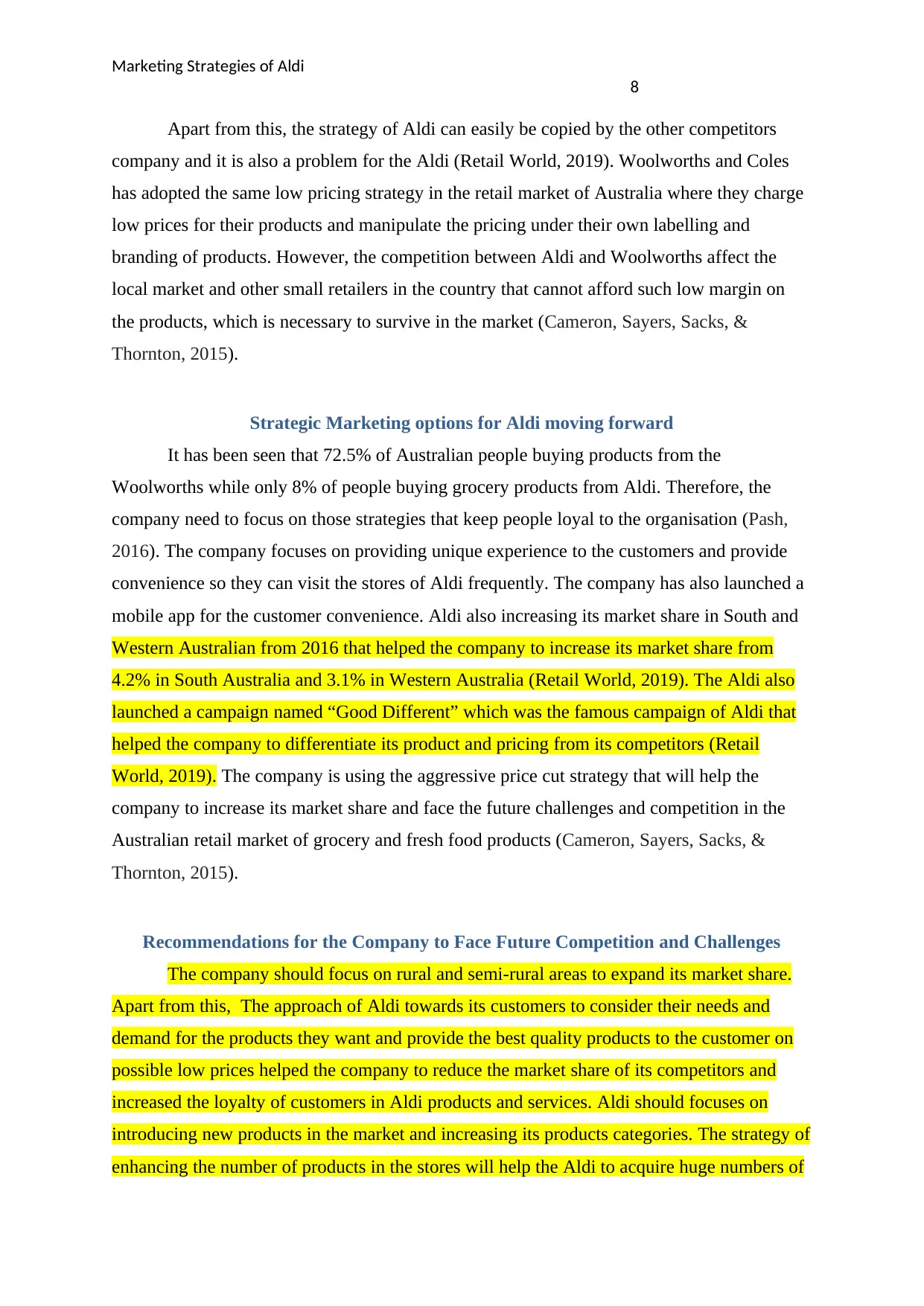
Marketing Strategies of Aldi
8
Apart from this, the strategy of Aldi can easily be copied by the other competitors
company and it is also a problem for the Aldi (Retail World, 2019). Woolworths and Coles
has adopted the same low pricing strategy in the retail market of Australia where they charge
low prices for their products and manipulate the pricing under their own labelling and
branding of products. However, the competition between Aldi and Woolworths affect the
local market and other small retailers in the country that cannot afford such low margin on
the products, which is necessary to survive in the market (Cameron, Sayers, Sacks, &
Thornton, 2015).
Strategic Marketing options for Aldi moving forward
It has been seen that 72.5% of Australian people buying products from the
Woolworths while only 8% of people buying grocery products from Aldi. Therefore, the
company need to focus on those strategies that keep people loyal to the organisation (Pash,
2016). The company focuses on providing unique experience to the customers and provide
convenience so they can visit the stores of Aldi frequently. The company has also launched a
mobile app for the customer convenience. Aldi also increasing its market share in South and
Western Australian from 2016 that helped the company to increase its market share from
4.2% in South Australia and 3.1% in Western Australia (Retail World, 2019). The Aldi also
launched a campaign named “Good Different” which was the famous campaign of Aldi that
helped the company to differentiate its product and pricing from its competitors (Retail
World, 2019). The company is using the aggressive price cut strategy that will help the
company to increase its market share and face the future challenges and competition in the
Australian retail market of grocery and fresh food products (Cameron, Sayers, Sacks, &
Thornton, 2015).
Recommendations for the Company to Face Future Competition and Challenges
The company should focus on rural and semi-rural areas to expand its market share.
Apart from this, The approach of Aldi towards its customers to consider their needs and
demand for the products they want and provide the best quality products to the customer on
possible low prices helped the company to reduce the market share of its competitors and
increased the loyalty of customers in Aldi products and services. Aldi should focuses on
introducing new products in the market and increasing its products categories. The strategy of
enhancing the number of products in the stores will help the Aldi to acquire huge numbers of
8
Apart from this, the strategy of Aldi can easily be copied by the other competitors
company and it is also a problem for the Aldi (Retail World, 2019). Woolworths and Coles
has adopted the same low pricing strategy in the retail market of Australia where they charge
low prices for their products and manipulate the pricing under their own labelling and
branding of products. However, the competition between Aldi and Woolworths affect the
local market and other small retailers in the country that cannot afford such low margin on
the products, which is necessary to survive in the market (Cameron, Sayers, Sacks, &
Thornton, 2015).
Strategic Marketing options for Aldi moving forward
It has been seen that 72.5% of Australian people buying products from the
Woolworths while only 8% of people buying grocery products from Aldi. Therefore, the
company need to focus on those strategies that keep people loyal to the organisation (Pash,
2016). The company focuses on providing unique experience to the customers and provide
convenience so they can visit the stores of Aldi frequently. The company has also launched a
mobile app for the customer convenience. Aldi also increasing its market share in South and
Western Australian from 2016 that helped the company to increase its market share from
4.2% in South Australia and 3.1% in Western Australia (Retail World, 2019). The Aldi also
launched a campaign named “Good Different” which was the famous campaign of Aldi that
helped the company to differentiate its product and pricing from its competitors (Retail
World, 2019). The company is using the aggressive price cut strategy that will help the
company to increase its market share and face the future challenges and competition in the
Australian retail market of grocery and fresh food products (Cameron, Sayers, Sacks, &
Thornton, 2015).
Recommendations for the Company to Face Future Competition and Challenges
The company should focus on rural and semi-rural areas to expand its market share.
Apart from this, The approach of Aldi towards its customers to consider their needs and
demand for the products they want and provide the best quality products to the customer on
possible low prices helped the company to reduce the market share of its competitors and
increased the loyalty of customers in Aldi products and services. Aldi should focuses on
introducing new products in the market and increasing its products categories. The strategy of
enhancing the number of products in the stores will help the Aldi to acquire huge numbers of
⊘ This is a preview!⊘
Do you want full access?
Subscribe today to unlock all pages.

Trusted by 1+ million students worldwide

Marketing Strategies of Aldi
9
customers in future and it will decrease the market share of other competitors. Apart from
this, the company’s strategy of focusing on fresh food products will give its advantages to
increase its market share of its products and it will help the company to increase its market
share that can be painful point for Coles and Woolworths in Australia
Conclusion
In conclusion, Aldi is known for its aggressive marketing strategy where the company
launched its product on very low prices and gain very low profit margin on the products. The
company operates its business in Australia in 2001 but now it is the third largest retailer in
the grocery and fresh food products in the country. Although, the focus of the company on
fresh food products specially and its aggressive cut in the prices of the products will help the
company to face the future challenges and competition in the market. However, the company
need to aware about the duplicity of its ideas and strategies that is generally done by its
competitors company in the market to stay competitive.
9
customers in future and it will decrease the market share of other competitors. Apart from
this, the company’s strategy of focusing on fresh food products will give its advantages to
increase its market share of its products and it will help the company to increase its market
share that can be painful point for Coles and Woolworths in Australia
Conclusion
In conclusion, Aldi is known for its aggressive marketing strategy where the company
launched its product on very low prices and gain very low profit margin on the products. The
company operates its business in Australia in 2001 but now it is the third largest retailer in
the grocery and fresh food products in the country. Although, the focus of the company on
fresh food products specially and its aggressive cut in the prices of the products will help the
company to face the future challenges and competition in the market. However, the company
need to aware about the duplicity of its ideas and strategies that is generally done by its
competitors company in the market to stay competitive.
Paraphrase This Document
Need a fresh take? Get an instant paraphrase of this document with our AI Paraphraser
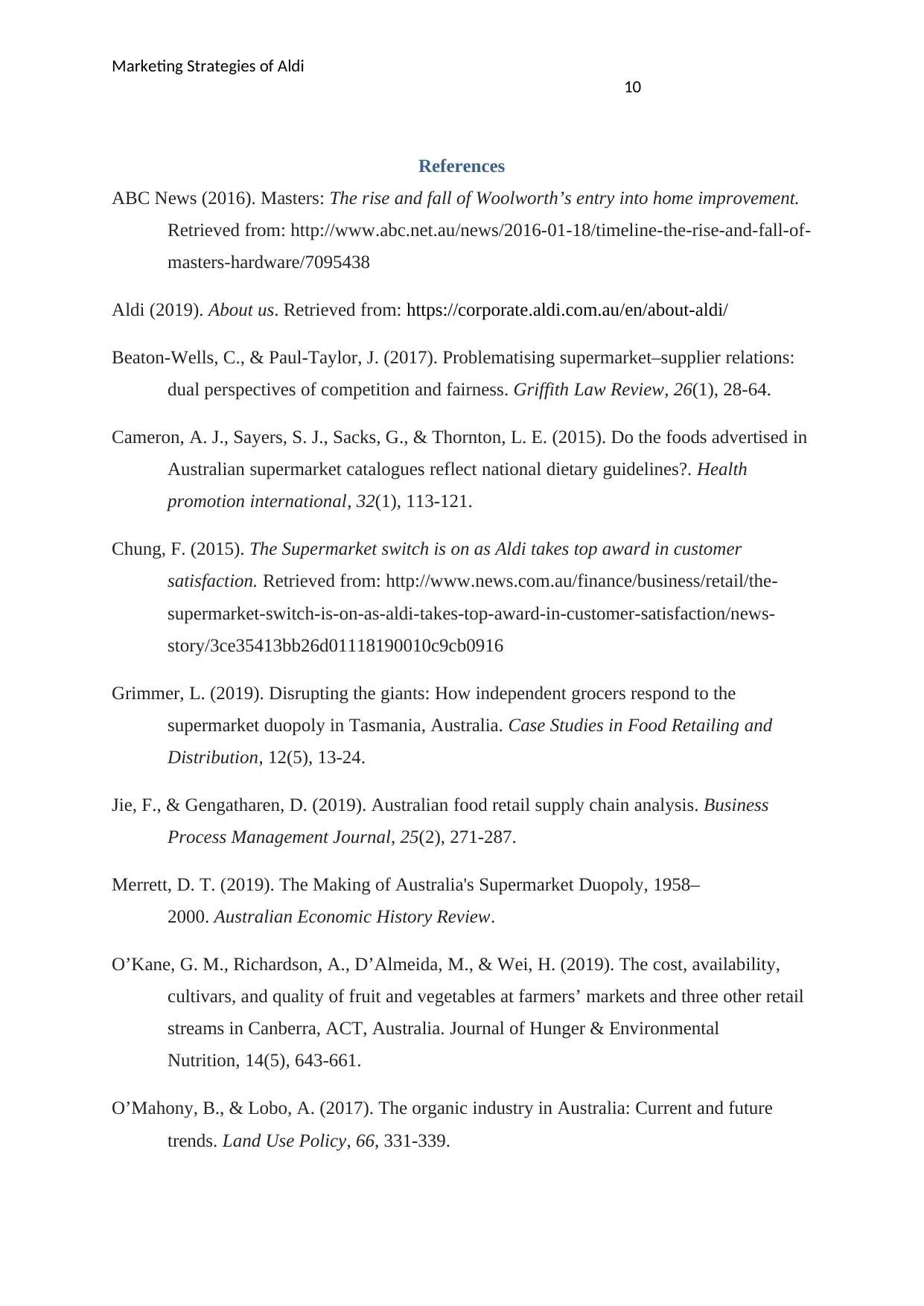
Marketing Strategies of Aldi
10
References
ABC News (2016). Masters: The rise and fall of Woolworth’s entry into home improvement.
Retrieved from: http://www.abc.net.au/news/2016-01-18/timeline-the-rise-and-fall-of-
masters-hardware/7095438
Aldi (2019). About us. Retrieved from: https://corporate.aldi.com.au/en/about-aldi/
Beaton-Wells, C., & Paul-Taylor, J. (2017). Problematising supermarket–supplier relations:
dual perspectives of competition and fairness. Griffith Law Review, 26(1), 28-64.
Cameron, A. J., Sayers, S. J., Sacks, G., & Thornton, L. E. (2015). Do the foods advertised in
Australian supermarket catalogues reflect national dietary guidelines?. Health
promotion international, 32(1), 113-121.
Chung, F. (2015). The Supermarket switch is on as Aldi takes top award in customer
satisfaction. Retrieved from: http://www.news.com.au/finance/business/retail/the-
supermarket-switch-is-on-as-aldi-takes-top-award-in-customer-satisfaction/news-
story/3ce35413bb26d01118190010c9cb0916
Grimmer, L. (2019). Disrupting the giants: How independent grocers respond to the
supermarket duopoly in Tasmania, Australia. Case Studies in Food Retailing and
Distribution, 12(5), 13-24.
Jie, F., & Gengatharen, D. (2019). Australian food retail supply chain analysis. Business
Process Management Journal, 25(2), 271-287.
Merrett, D. T. (2019). The Making of Australia's Supermarket Duopoly, 1958–
2000. Australian Economic History Review.
O’Kane, G. M., Richardson, A., D’Almeida, M., & Wei, H. (2019). The cost, availability,
cultivars, and quality of fruit and vegetables at farmers’ markets and three other retail
streams in Canberra, ACT, Australia. Journal of Hunger & Environmental
Nutrition, 14(5), 643-661.
O’Mahony, B., & Lobo, A. (2017). The organic industry in Australia: Current and future
trends. Land Use Policy, 66, 331-339.
10
References
ABC News (2016). Masters: The rise and fall of Woolworth’s entry into home improvement.
Retrieved from: http://www.abc.net.au/news/2016-01-18/timeline-the-rise-and-fall-of-
masters-hardware/7095438
Aldi (2019). About us. Retrieved from: https://corporate.aldi.com.au/en/about-aldi/
Beaton-Wells, C., & Paul-Taylor, J. (2017). Problematising supermarket–supplier relations:
dual perspectives of competition and fairness. Griffith Law Review, 26(1), 28-64.
Cameron, A. J., Sayers, S. J., Sacks, G., & Thornton, L. E. (2015). Do the foods advertised in
Australian supermarket catalogues reflect national dietary guidelines?. Health
promotion international, 32(1), 113-121.
Chung, F. (2015). The Supermarket switch is on as Aldi takes top award in customer
satisfaction. Retrieved from: http://www.news.com.au/finance/business/retail/the-
supermarket-switch-is-on-as-aldi-takes-top-award-in-customer-satisfaction/news-
story/3ce35413bb26d01118190010c9cb0916
Grimmer, L. (2019). Disrupting the giants: How independent grocers respond to the
supermarket duopoly in Tasmania, Australia. Case Studies in Food Retailing and
Distribution, 12(5), 13-24.
Jie, F., & Gengatharen, D. (2019). Australian food retail supply chain analysis. Business
Process Management Journal, 25(2), 271-287.
Merrett, D. T. (2019). The Making of Australia's Supermarket Duopoly, 1958–
2000. Australian Economic History Review.
O’Kane, G. M., Richardson, A., D’Almeida, M., & Wei, H. (2019). The cost, availability,
cultivars, and quality of fruit and vegetables at farmers’ markets and three other retail
streams in Canberra, ACT, Australia. Journal of Hunger & Environmental
Nutrition, 14(5), 643-661.
O’Mahony, B., & Lobo, A. (2017). The organic industry in Australia: Current and future
trends. Land Use Policy, 66, 331-339.
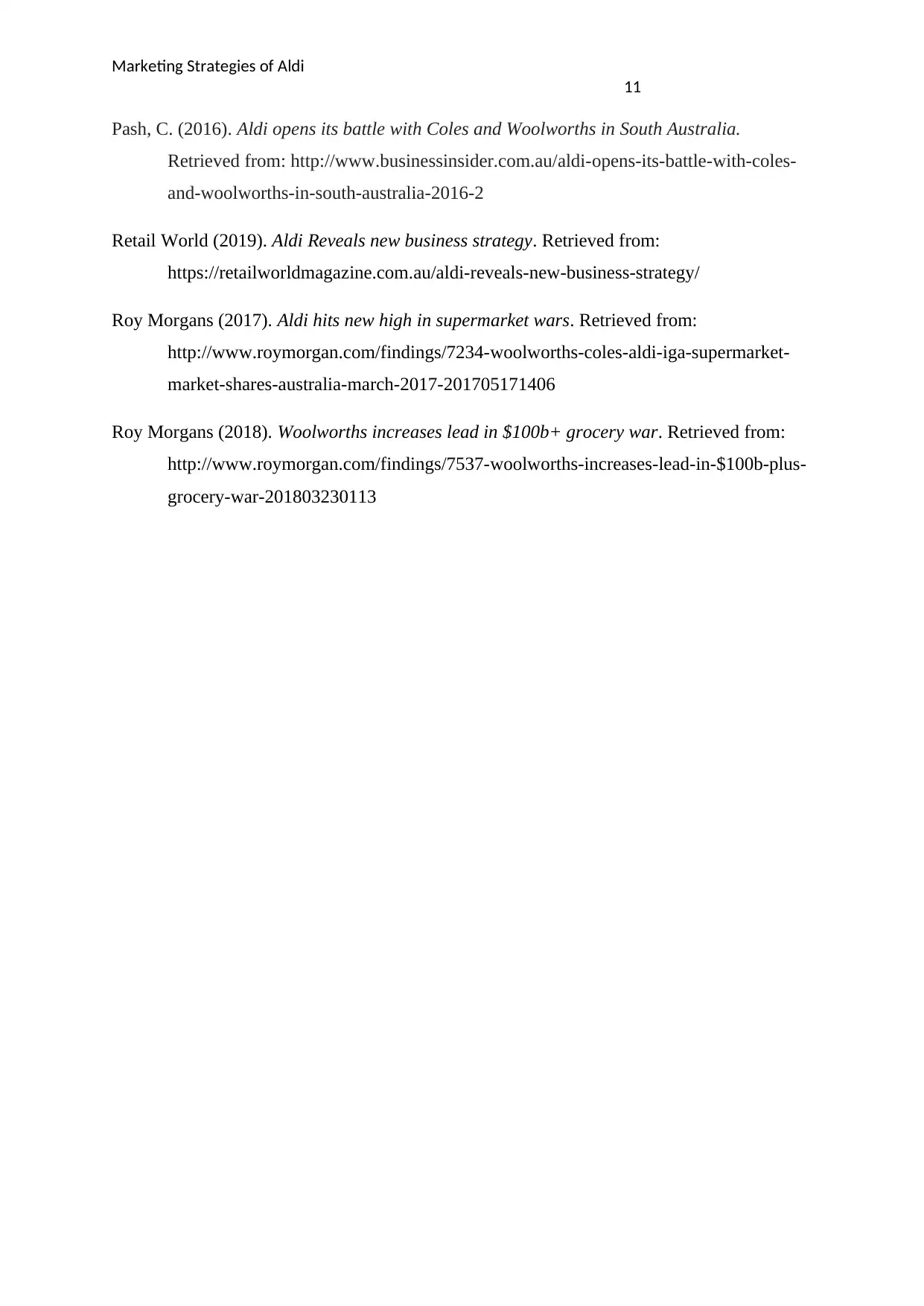
Marketing Strategies of Aldi
11
Pash, C. (2016). Aldi opens its battle with Coles and Woolworths in South Australia.
Retrieved from: http://www.businessinsider.com.au/aldi-opens-its-battle-with-coles-
and-woolworths-in-south-australia-2016-2
Retail World (2019). Aldi Reveals new business strategy. Retrieved from:
https://retailworldmagazine.com.au/aldi-reveals-new-business-strategy/
Roy Morgans (2017). Aldi hits new high in supermarket wars. Retrieved from:
http://www.roymorgan.com/findings/7234-woolworths-coles-aldi-iga-supermarket-
market-shares-australia-march-2017-201705171406
Roy Morgans (2018). Woolworths increases lead in $100b+ grocery war. Retrieved from:
http://www.roymorgan.com/findings/7537-woolworths-increases-lead-in-$100b-plus-
grocery-war-201803230113
11
Pash, C. (2016). Aldi opens its battle with Coles and Woolworths in South Australia.
Retrieved from: http://www.businessinsider.com.au/aldi-opens-its-battle-with-coles-
and-woolworths-in-south-australia-2016-2
Retail World (2019). Aldi Reveals new business strategy. Retrieved from:
https://retailworldmagazine.com.au/aldi-reveals-new-business-strategy/
Roy Morgans (2017). Aldi hits new high in supermarket wars. Retrieved from:
http://www.roymorgan.com/findings/7234-woolworths-coles-aldi-iga-supermarket-
market-shares-australia-march-2017-201705171406
Roy Morgans (2018). Woolworths increases lead in $100b+ grocery war. Retrieved from:
http://www.roymorgan.com/findings/7537-woolworths-increases-lead-in-$100b-plus-
grocery-war-201803230113
⊘ This is a preview!⊘
Do you want full access?
Subscribe today to unlock all pages.

Trusted by 1+ million students worldwide
1 out of 12
Related Documents
Your All-in-One AI-Powered Toolkit for Academic Success.
+13062052269
info@desklib.com
Available 24*7 on WhatsApp / Email
![[object Object]](/_next/static/media/star-bottom.7253800d.svg)
Unlock your academic potential
© 2024 | Zucol Services PVT LTD | All rights reserved.




